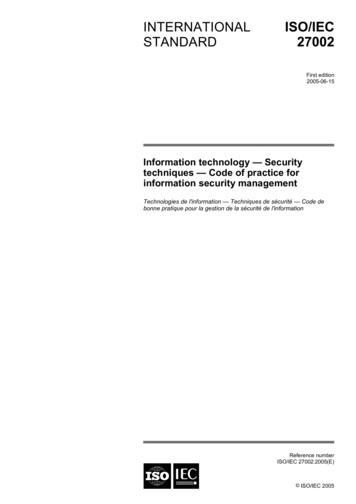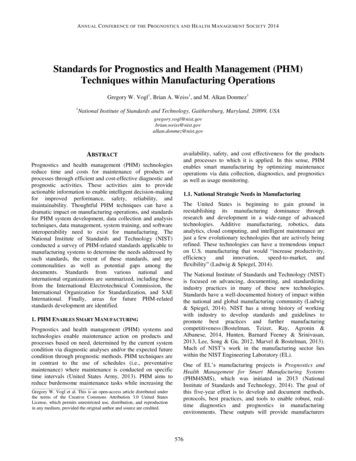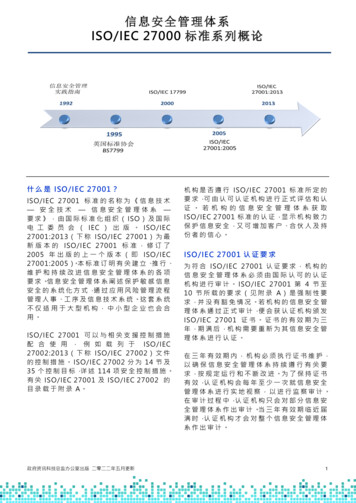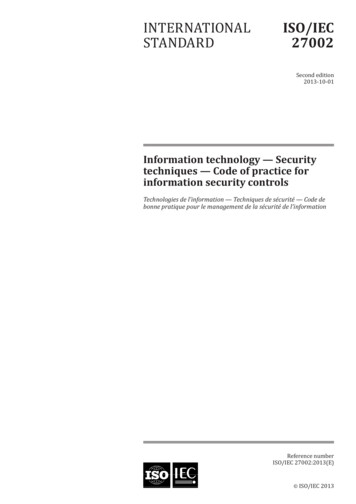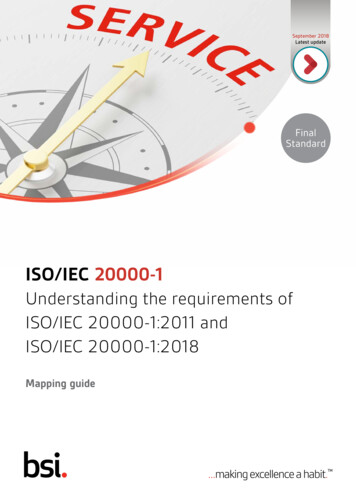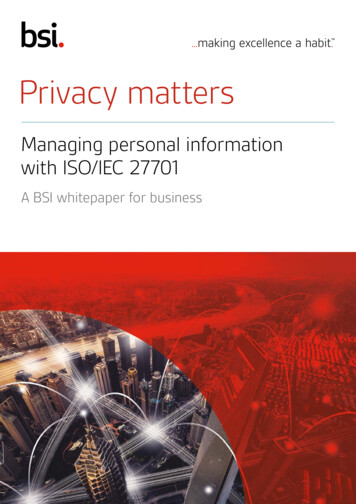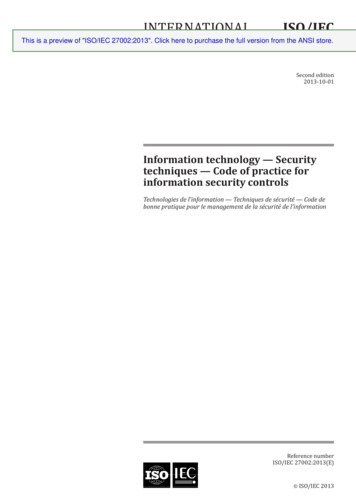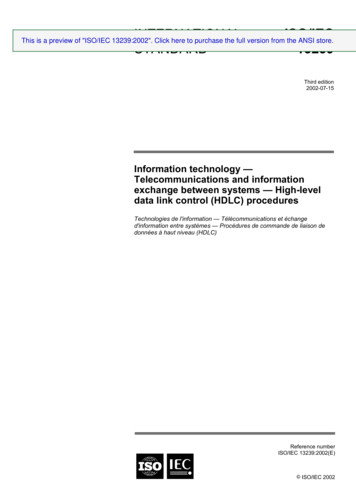
Transcription
INTERNATIONALSTANDARDISO/IEC13239This is a preview of "ISO/IEC 13239:2002". Click here to purchase the full version from the ANSI store.Third edition2002-07-15Information technology —Telecommunications and informationexchange between systems — High-leveldata link control (HDLC) proceduresTechnologies de l'information — Télécommunications et échanged'information entre systèmes — Procédures de commande de liaison dedonnées à haut niveau (HDLC)Reference numberISO/IEC 13239:2002(E) ISO/IEC 2002
ISO/IEC 13239:2002(E)This is a preview of "ISO/IEC 13239:2002". Click here to purchase the full version from the ANSI store.PDF disclaimerThis PDF file may contain embedded typefaces. In accordance with Adobe's licensing policy, this file may be printed or viewed but shall notbe edited unless the typefaces which are embedded are licensed to and installed on the computer performing the editing. In downloading thisfile, parties accept therein the responsibility of not infringing Adobe's licensing policy. The ISO Central Secretariat accepts no liability in thisarea.Adobe is a trademark of Adobe Systems Incorporated.Details of the software products used to create this PDF file can be found in the General Info relative to the file; the PDF-creation parameterswere optimized for printing. Every care has been taken to ensure that the file is suitable for use by ISO member bodies. In the unlikely eventthat a problem relating to it is found, please inform the Central Secretariat at the address given below. ISO/IEC 2002All rights reserved. Unless otherwise specified, no part of this publication may be reproduced or utilized in any form or by any means, electronicor mechanical, including photocopying and microfilm, without permission in writing from either ISO at the address below or ISO's member bodyin the country of the requester.ISO copyright officeCase postale 56 CH-1211 Geneva 20Tel. 41 22 749 01 11Fax 41 22 749 09 47E-mail copyright@iso.chWeb www.iso.chPrinted in Switzerlandii ISO/IEC 2002 – All rights reserved
ISO/IEC 13239:2002(E)This is a preview of "ISO/IEC 13239:2002". Click here to purchase the full version from the ANSI store.ContentsPageForeword .vIntroduction .vi1Scope.12Normative references .233.13.2Definitions, acronyms and abbreviations.3Definitions .3Acronyms and abbreviations.844.14.24.34.44.54.64.74.84.9HDLC frame structure .10Frame formats .11Elements of the frame .12Transparency.15Transmission considerations .17Inter-frame time fill .17Invalid frame .17Extensions .18Addressing conventions .18Frame format field .1955.15.25.35.45.55.6HDLC elements of procedures .21Data link channel states .21Modes .22Control field formats.25Control field parameters .27Commands and responses .31Exception condition reporting and recovery 46.15HDLC classes of procedures.58Types of data station .59Configurations.60Operational modes .60Addressing scheme .60Send and receive state variables .60Fundamental classes of procedures .60Optional functions.62Consistency of classes of procedures .62Conformance to the HDLC classes of procedures.62Method of indicating classes and optional functions.63Unbalanced operation (point-to-point and multipoint) .66Balanced operation (point-to-point) .69Unbalanced connectionless operation (point-to-point and multipoint) .73Balanced connectionless operation (point-to-point) .76Uses of the optional functions.7877.17.27.37.47.5General purpose Exchange Identification (XID) frame.85General purpose XID frame information field structure .85General purpose XID frame information field encoding.85Single-frame exchange negotiation process.91Frame check sequence negotiation rules .92Rules for negotiation use of the frame format field in non-basic frame format mode .9388.1Resolution/negotiation of data link layer address in switched environments .93Operational requirements .93 ISO/IEC 2002 – All rights reservediii
ISO/IEC 13239:2002(E)This is a preview of "ISO/IEC 13239:2002". Click here to purchase the full version from the ANSI store.8.2Address resolution . 94Annex A (informative) Explanatory notes on the implementation of the frame checking sequence . 95Annex B (informative) Example of the use of commands and responses . 97Annex C (informative) Time-out function considerations for NRM, ARM and ABM . 118Annex D (informative) Examples of typical HDLC procedural subsets. 120Annex E (informative) Illustrative examples of 16/32-bit FCS negotiation . 123Annex F (informative) Guidelines for communicating with LAPB X.25 DTEs. 125Annex G (informative) Examples of information field encoding in multi-selective reject frames . 126Annex H (normative) Frame format types. 127iv ISO/IEC 2002 – All rights reserved
ISO/IEC 13239:2002(E)This is a preview of "ISO/IEC 13239:2002". Click here to purchase the full version from the ANSI store.ForewordISO (the International Organization for Standardization) and IEC (the International Electrotechnical Commission) form thespecialized system for worldwide standardization. National bodies that are members of ISO or IEC participate in thedevelopment of International Standards through technical committees established by the respective organization to deal withparticular fields of technical activity. ISO and IEC technical committees collaborate in fields of mutual interest. Otherinternational organizations, governmental and non-governmental, in liaison with ISO and IEC, also take part in the work. Inthe field of information technology, ISO and IEC have established a joint technical committee, ISO/IEC JTC 1.International Standards are drafted in accordance with the rules given in the ISO/IEC Directives, Part 3.The main task of the joint technical committee is to prepare International Standards. Draft International Standards adopted bythe joint technical committee are circulated to national bodies for voting. Publication as an International Standard requiresapproval by at least 75 % of the national bodies casting a vote.Attention is drawn to the possibility that some of the elements of this International Standard may be the subject of patentrights. ISO and IEC shall not be held responsible for identifying any or all such patent rights.ISO/IEC 13239 was prepared by Joint Technical Committee ISO/IEC JTC 1, Information technology, Subcommittee SC 6,Telecommunications and information exchange between systems.This third edition cancels and replaces the second edition (ISO/IEC 13239:2000), which has been technically revised. It alsocancels and replaces ISO/IEC 3309:1993, ISO/IEC 4335:1993, ISO/IEC 7809:1993 and ISO/IEC 8885:1993.Annex H forms a normative part of this International Standard. Annexes A to G are for information only. ISO/IEC 2002 – All rights reservedv
ISO/IEC 13239:2002(E)This is a preview of "ISO/IEC 13239:2002". Click here to purchase the full version from the ANSI store.IntroductionThis third edition adds a new frame format type to Annex H – Frame format types. This frame format type is used in thoseenvironments where additional error protection, identification of both the source and the destination(s), and/or longer framesizes are needed.High-level data link control (HDLC) procedures are designed to permit synchronous or start/stop, code-transparent datatransmission. The normal cycle of the code-transparent data communication between two data stations consists of the transferof frames containing information from the data source to the data sink acknowledged by a frame in the opposite direction.Generally, until the data station comprising the data source receives an acknowledgement, it holds the original information inmemory in case the need should arise for retransmissions.In those situations that require it, data sequence integrity between the data source and the data sink is effected by means of anumbering scheme, which is cyclic within a specified modulus and measured in terms of frames. An independent numberingscheme is used for each data source/data sink combination on the data link.The acknowledgement function is accomplished by the data sink informing the data source of the next expected sequencenumber. This can be done in a separate frame, not containing information, or within the control field of a frame containinginformation.HDLC procedures are applicable to unbalanced data links and to balanced data links.Unbalanced data linksAn unbalanced data link involves two or more participating data stations. For control purposes, one data station on the datalink assumes responsibility for the organization of data flow and for unrecoverable data link level error conditions. The datastation assuming these responsibilities is known as the primary station in unbalanced connection-mode data links and as thecontrol station in unbalanced connectionless-mode data links, and the frames it transmits are referred to as command frames.The other data stations on the data link are known as the secondary stations in unbalanced connection-mode data links and asthe tributary stations in unbalanced connectionless-mode data links, and the frames they transmit are referred to as responseframes.For the transfer of data between the primary/control station and the secondary/tributary stations, two cases of data link controlare considered (see figures A and B). In the first case, the data station comprising the data source performs a primary/controlstation data link control function and controls the data station comprising the data sink that is associated with asecondary/tributary station data link control function, by select-type commands.In the second case, the data station comprising the data sink performs a primary/control station data link control function andcontrols the data station comprising the data source that is associated with a secondary/tributary station data link controlfunction, by poll-type commands.The information flows from the data source to the data sink, and the acknowledgements are always transmitted in the oppositedirection.These two cases of data link control may be combined so that the data link becomes capable of two-way alternatecommunication, or two-way simultaneous communication.vi ISO/IEC 2002 – All rights reserved
ISO/IEC 13239:2002(E)This is a preview of "ISO/IEC 13239:2002". Click here to purchase the full version from the ANSI ndary/TributarystationAcknowledgementData sourceData sinkFigure A — Unbalanced data link functions (case 1)Primary/ControlstationData tarystationData sourceFigure B — Unbalanced data link functions (case 2)Balanced data linksA balanced data link involves only two participating data stations. For control purposes, each data station assumesresponsibility for the organization of its data flow and for unrecoverable data link level error conditions associated with thetransmissions that it originates. Each data station is known as a combined station in balanced connection-mode data links andas a peer station in balanced connectionless-mode data links and is capable of transmitting and receiving both command andresponse frames.For the transfer of data between combined/peer stations, the data link control functions illustrated in figure C are utilized. Thedata source in each combined/peer station controls the data sink in the other combined/peer station by the use of select-typecommands. The information flows from the data source to the data sink, and the acknowledgements are always transmitted inthe opposite direction. The poll-type commands may be used by each combined/peer station to solicit acknowledgements andstatus responses from the other combined/peer ation/acknowledgement/pollData sink/data sourceData sink/data sourceFigure C — Balanced data link functionsData link configurationsHDLC classes of procedures describe methods of data link operation which permit synchronous or start/stop, code-transparentdata transmission between data stations in a variety of logical and physical configurations. The classes are defined in aconsistent manner within the framework of an overall HDLC architecture. One of the purposes of this International Standard isto maintain maximum compatibility between the basic types of procedures, unbalanced, balanced and connectionless, as this isparticularly desirable for data stations with configurable capability, which may have the characteristics of a primary,secondary, combined, control, tributary, or peer station, as required for a specific instance of communication.Five fundamental classes of procedures (two unbalanced, one balanced, and two connectionless) are defined herein. Theunbalanced classes apply to both point-to-point and multipoint configurations (as illustrated in figure D using theprimary/secondary nomenclature) over either dedicated or switched data transmission facilities. A characteristic of theunbalanced classes is the existence of a single primary station at one end of the data link plus one or more secondary stations atthe other end(s) of the data link. The primary station alone is responsible for data link management, hence the designation"unbalanced" classes of procedures. ISO/IEC 2002 – All rights reservedvii
ISO/IEC 13239:2002(E)This is a preview of "ISO/IEC 13239:2002". Click here to purchase the full version from the ANSI tionASecondary/TributarystationNFigure D — Unbalanced data link configurationThe unbalanced connectionless class applies to point-to-point configurations over either dedicated or switched datatransmission facilities, or to multipoint configurations over dedicated data transmission facilities (as illustrated in figure Dusing the control/tributary nomenclature). A characteristic of the unbalanced connectionless class is the existence of a singlecontrol station at one end of the data link plus one or more tributary stations at the other end(s) of the data link. The controlstation is responsible for determining when a tributary station is permitted to send. Neither the control station nor the tributarystation(s) support any form of connection establishment/termination procedures, flow control procedures, data transferacknowledgement procedures, or error recorvery procedures, hence the designation “connectionless” class of procedures.The balanced class applies to point-to-point configurations (as illustrated in figure E using the combined nomenclature) overeither dedicated or switched data transmission facilities. A characteristic of the balanced class is the existence of two datastations, called combined stations, on a logical data link, that may share equally in the responsibility for data link management,hence the designation "balanced" class of ionBFigure E — Balanced data link configurationThe balanced connectionless class applies to point-to-point configurations over either dedicated or switched data transmissionfacilities (as illustrated in figure E using the peer nomenclature). A characteristic of the balanced connectionless class is theexistence of two data stations, called peer stations, on a data link, that are each independently in control of when they can send.Neither peer station supports any form of connection establishment/termination procedures, flow control procedures, datatransfer acknowledgement procedures, or error recovery procedures, hence the designation "connectionless" class ofprocedures.For each class of procedures, a method of operation is specified in terms of the capabilities of the basic repertoire of commandsand responses that are found in that class.A variety of optional functions are also listed. Procedural descriptions for the use of the optional functions are defined.It is recognized that it is possible to construct symmetrical configurations for operation on a single data circuit from theunbalanced classes of procedures which are defined in this International Standard. For example, the combination of twounbalanced procedures (with I frame flow as commands only) in opposite directions would create a symmetrical point-to-pointconfiguration (as illustrated in figure F).viii ISO/IEC 2002 – All rights reserved
ISO/IEC 13239:2002(E)This is a preview of "ISO/IEC 13239:2002". Click here to purchase the full version from the ANSI ystation2IIPrimarystation2Figure F — Symmetrical data link configurationThese HDLC procedures define the exchange identification (XID) command/response frame as an optional function forexchange of data link information (identification, parameters, functional capability, etc.). The content and format for a generalpurpose XID frame information field is defined.These HDLC procedures also specify the parameters and procedures which may be employed by two data stations to mutuallydetermine the data link layer addresses to be used, prior to logical data link establishment. ISO/IEC 2002 – All rights reservedix
This third edition cancels and replaces the second edition (ISO/IEC 13239:2000), which has been technically revised. It also cancels and replaces ISO/IEC 3309:1993, ISO/IEC 4335:1993, ISO/IEC 7809:1993 and ISO/IEC 8885:1993. Annex H forms a normative part of this International Standard. Annexes A to G are for information only.

